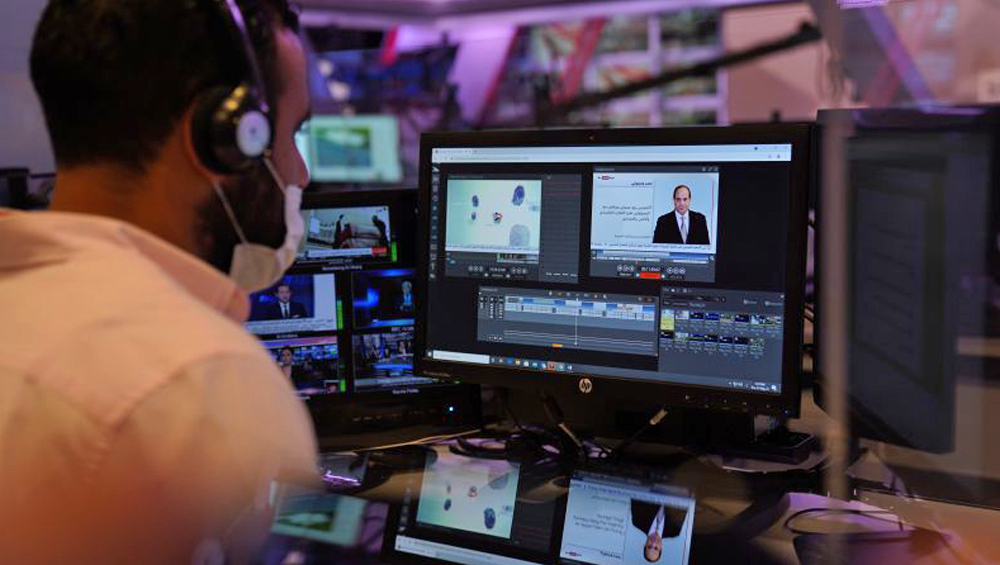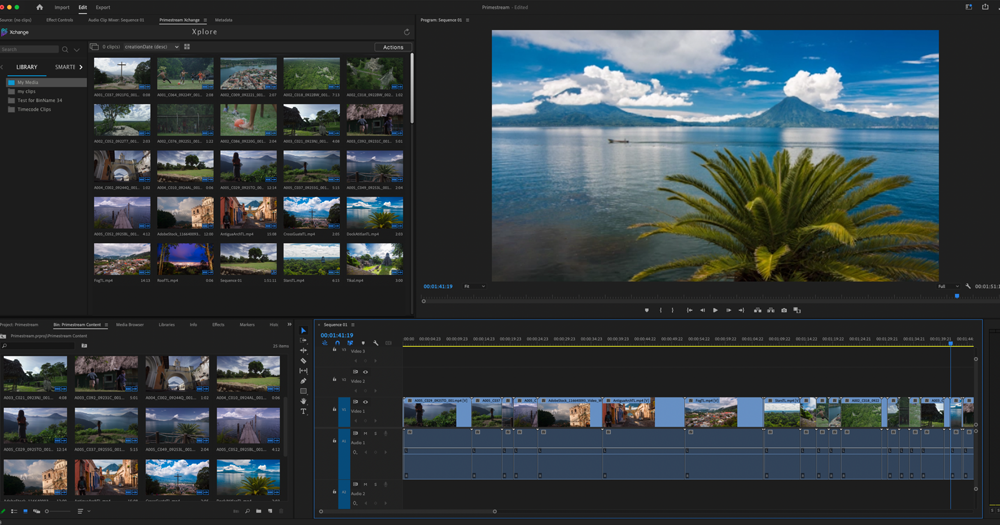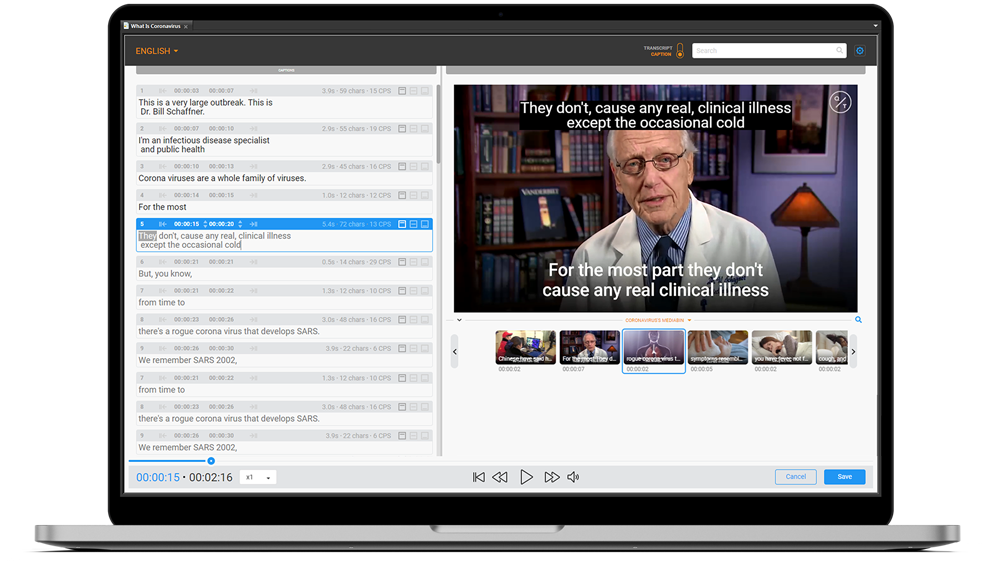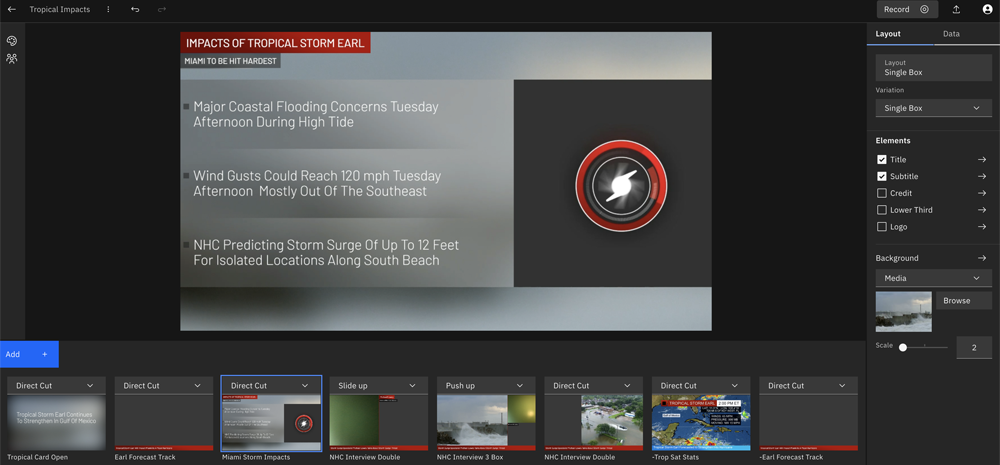
Cloud Editing Embraces More Flexibility, Efficiency

Nearly three years after broadcasters jumped into remote and cloud editing due to the COVID pandemic, the technologies have evolved to better support collaboration, speed and automation.
While the cloud enables speed and collaboration along with flexibility and redundancy, cloud operations can be costly. For instance, editing the high-resolution content the industry likes to work with on the cloud can be fairly expensive, so broadcasters may choose alternatives like working with lower-res proxies, hybrid workflows or remote editing.
Vendors are working to optimize the workflows and provide technologies that can further speed up content creation. The editing software and services are increasingly making available automation capabilities for tedious and time-consuming tasks.
Peter Abecassis, senior product marketing manager at Grass Valley, says broadcasters appreciate how the cloud helps with news team collaboration.
“The main goal is to collaborate, for efficiency, to have access to talent without moving them,” he says.
Not only does it allow people to work from anywhere, it makes it easier for people in different regions to work together, he says.

AMPP’s Framelight X media asset management system from Grass Valley includes an AI-powered speech-to-text workflow to speed up the creation of highlight packages in its HTML5 editor.
If a broadcaster wanted the top editors working on a project, but they were not available to work in the production suite, “you could grab someone from Dallas, Houston and Kansas City, and they could all work on the same project because it’s cloud based,” Abecassis says.
He says the company’s Framelight X includes an HTML5 editor that allows editors anywhere in the world with internet access to access the broadcaster’s media assets. Whether the file resides in studio storage or in the cloud, he says, “it looks like one massive storage system to any user.”
Grass Valley is also working on “any automation we can bring on board” to speed up content creation workflows, he says.
“A lot of our tools are geared around how to take content — specifically live content — and turn it around quickly, to help media producers maximize the revenue they get for a specific event,” Abecassis says.
Bitcentral Chief Operating Officer Sam Peterson says he’s seen a trend toward having ubiquitous access to source content for collaborative editing. A couple of years ago, Bitcentral and Nexstar collaborated to complete re-write Bitcentral’s Create browser-based editor to provide that kind of capability. Create, initially, was designed to be used inside the station.
“It’s cloud-friendly. Anyone anywhere any time can access all the content they have access to,” he says. “We spent a lot of time and energy building that out.”

Bitcentral’s Create maximizes the value of media through enhanced editing capabilities and workflow efficiencies at faster speed through a simple and feature-rich user interface that is available anywhere.
He also says broadcasters want technologies that help them do things more quickly.
“One of the key factors 20 years ago and still today is ‘how fast can I turn this content, get that content distributed to a consumer?’” he says. “For us, the focus has been speed, and what does the cloud do for speed?”
One of the things that can drive efficiencies for news teams is to have centralized content, whether that be on the cloud or servers, Daniel Webster, Blackbird’s VP Americas, says. Once that content is centralized, it’s possible to have the best editors and journalists working on the content.
The point, he says, is to make it as easy as possible to edit content, and a centralized creation tool like Blackbird can do that.
“It’s about simplicity of workflow and making it really easy for anyone in a newsroom” or out in the field to edit, Webster says.

Blackbird provides Sky News Arabia universal access to video for edit story creation and multiplatform publishing, enabling news, sports and media organizations to reach their audiences wherever they are.
One of the big problems that Blackbird wants to solve is the “equation that it takes an hour to create one minute of video,” he says. “That’s a fundamentally crazy metric which we want to tear apart.”
And artificial intelligence is on the company’s roadmap as a way to help speed the creation and editing processes, according to Blackbird CEO Ian McDonough.
“The way we think about our product in the future is the hub where all those different technologies can be integrated,” McDonough says. “It’s all about speed. Speed in news is better for the viewer, better for the business.”
Emeka Okoli, Zixi’s VP for business solutions and customer success, says reducing latency is a priority for broadcasters.
“Reducing latency in live production is critical,” he says. “The sooner the content gets there, edited and marked up for additional curation for specific regions, the better you are for getting content to your viewership. It’s a bit of a race.”
Zixi’s platform allows for a stream and store function, as well as store and stream.
With those features, Okoli says, a journalist can “capture events on the move and be able to not worry about setting a time and being stationary before pushing it to the cloud.”
Chris Braehler, VP of product at SDVI, says the move toward editing in the cloud has accelerated greatly, with some broadcasters jumping straight to cloud and some using remote editing and on-prem machines.
“The technology was the same, whether it was in the cloud or on-prem, the remote part of this,” he says. “A hurdle of remote editing solutions was around editors feeling the responsiveness of the tool not quite the same.”

SDVI’s Rally Access is a metadata-assisted content QC and compliance service. It combines content and metadata on the editor’s timeline, guiding them to the right moment and track where content requires their attention.
And there tend to be two main schools of thinking around cloud editing, he adds.
Proxy editing is when the user edits a proxy, low-res version of the content locally on the user’s machine.
In this case, “only the edits that I’ve done are sent to the cloud where the high-res version is, and the conforming and rendering of the edit happens in the cloud. The editor has the machine locally, and it feels snappier,” Braehler says.
The other option is to edit high-res content, but move the editing software, such as Adobe Premier, into the cloud.
While the editor is working on the high-res version, he says, some editors don’t prefer that approach because of the “microsecond of delay there.”
SDVI’s Rally Access works with both approaches, he says.
Flexibility is also something broadcasters want.
Alan Dabul, product manager for media asset management at Ross Video, says most of the Ross customers’ workflows tend more toward remote access than cloud.
“Most of our customers are on-prem and only pieces of the workflow are cloud,” he says. “We’re starting to see more customers interested in exploring what’s possible.”
In short, he says, the video-heavy workflows are done on-prem with video editing done remotely via VPN that pulls a proxy to the local edit base and sends exports back to the on-prem facility.
“They want some of their staff accessing the content on-prem to do the workflows on premises, especially the video editing process” for 4K and 8K video, he says. “It just costs too much, and it’s unfeasible to provide remote access for some of those workflows.”
Ross’s Primestream solutions are capable of living completely in the cloud, he says, and they “look the same if it’s on-prem or in the cloud.”

Ross Video’s Primestream simplifies and accelerates cloud and on-prem content creation by providing remote video editing workflows directly integrated with Adobe Premiere Pro.
Editing can be done through an Adobe Premiere plug-in that allows editors to interact with content from shared storage, whether the editors are on-prem or remotely accessing the content, Dabul says. Editors can also do rough cuts and create a sequence for content that integrates with the Adobe Premiere workflow where it can be passed to an editor for elements like titles, graphics and transitions, he says.
Mathieu Zarouk, director of product marketing at Dalet, says there are three main families of solutions available for broadcasters seeking to use cloud editing. The simplest are fast clipping quick-turnaround workflows, followed by full-fledged web editors, he says. The traditional editing tools can also be deployed in the cloud, he says.

Dalet Media Cortex is an AI service platform designed to leverage cognitive services and machine learning.
Typically, the clipping tools enable fast turnaround and publishing require little editing, but are useful when time is of the essence, such as for live feeds or sports events, Zarouk says. The web-based editors are alternatives to traditional non-linear editing (NLE) programs like Premiere or Media Composer, he says, while the traditional editing tools have cloud-based options, typically enabled by a third party through an asset management system, he says.
“We’ve been working quite a lot this year to better enable traditional NLEs in remote settings. For instance, with Adobe Premiere, we can now enable proxy-based workflows and remote rendering workflows,” he says. “Dalet Flex will take care of analyzing the project, relinking the high-resolution files instead of the proxy files. Basically, still relying on this traditional NLE tool that is in Premiere, but enabling cloud-compatible workflows.”
Jim Politis, the Max Cloud product manager at The Weather Company, says Max Cloud gives stations the ability to store and access their weather content in the cloud, although it’s not itself a video editor. Velocity, however, gives Max Cloud users the ability to assemble a story from the browser.

The Weather Company’s Max Velocity gives Max Cloud users the ability to assemble a story from the browser.
“In Velocity you can create stories and control of all the media content you want as part of your story,” Politis says.
Velocity, released April 2022, allows for basic trimming of the video content.
“It streamlines story creation so you can apply story clips at the time of recording,” he says. “It reduces the need to use a full on video editor before publication.”
Raul Alba, Avid’s director of market solutions, says the cloud is a tool that broadcasters can use and shouldn’t be considered a goal.
The company offers Edit on Demand and Media Central, which are normally aimed at different users, he says, but “one edit could be started in the easier-to-use Media Central web interface and finished in the more complex Edit On Demand interface,” which uses the Media Composer editor.
He says Avid has been working on web-based technologies to ensure the Media Central web interface is easy to use and reactive with as many features as possible but still light enough that it works anywhere.
The Edit on Demand offering makes available Avid’s Media Composer editor in a flexible way, with users paying as they go for what they use, he says.
When it comes to market needs and technologies, Alba says broadcasters need efficiency more than disruption.
“They are more worried about being efficient and being lean, rather than looking for the next big disruption, the next big thing,” he says. “I think 2023 will be the year of efficiency and flexibility.”
































Comments (1)
elizabethgorgon1 says:
February 23, 2023 at 6:18 am
No wonder they are growing in popularity all over the world. But before you start migrating your infrastructure to the cloud, be sure to analyze your software and consult with experts https://www.chinatelecomasiapacific.com/cloud-infrastructure for an effective result.